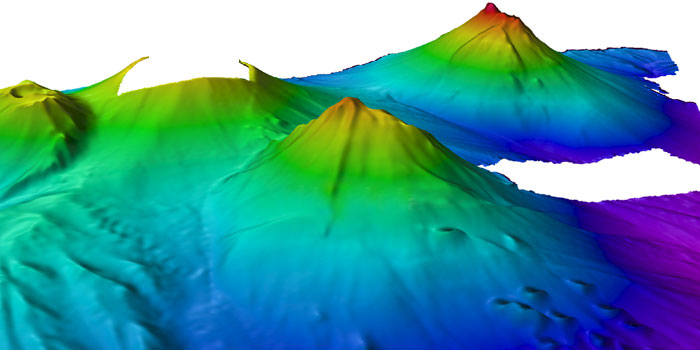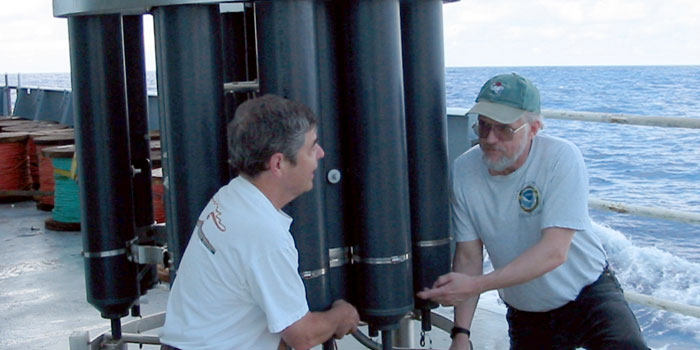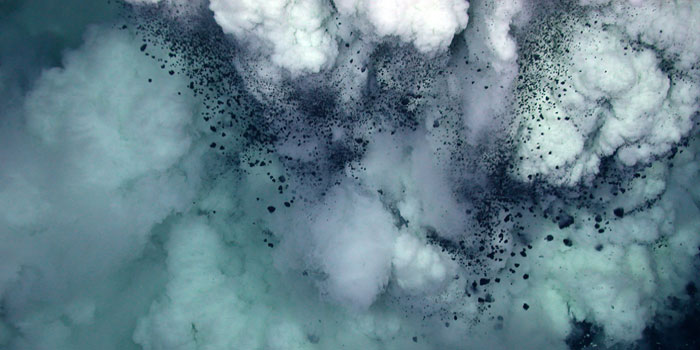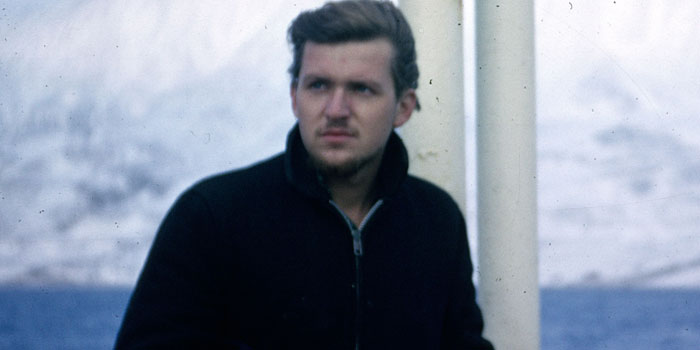Dr. Bob Embley: Video Transcript
Hear Bob talk about his job and what it's like to conduct science while at sea. Download (mp4, 424 MB).
Introduction
Hi, I’m Bob Embley and I work here at the Pacific Marine Environmental Lab at Newport, Oregon and I am a Marine Geologist. I’ve been doing this work for about forty years. I am a specialist in marine geology. I work a lot with maps and make maps of the seafloor and try to understand what processes are forming the seafloor, in particular the underwater volcanoes in the island arcs in the Western Pacific. We spend a lot of time analyzing seafloor imagery and images and maps.

Bob talks about how ocean exploration—the tools and the quest—have changed over time.
Ocean Exploration
One of the things I have been thinking about is how what we do now in ocean exploration differs from how things were when I started out in this business, which goes back to the 1960’s. In those days we were finding new features and exploring and in fact, by the time I became a graduate student the great age of initial age of ocean exploration was just sort of winding down and there was a broad hypothesis of seafloor spreading and plate tectonics that was just forming. Part of the reason we were out there was to prove or disprove that hypothesis. We were also discovering new features on the sea floor and new phenomenon all the time. Now days it is a little different in that we have a lot more precise tools, we can find out where we are all the time either on the surface or the sea floor, we have the navigational tools which are far superior than anything we had then. In some ways it hasn’t changed. We have some broad overarching hypothesizes. Fro instance we think that volcanoes that are on the Island Arcs.

What is it like to do research at sea? What challenges do you face? Who do you work with?
Research At Sea
While I am at sea if varies at bit. I am often in charge of the cruise as the chief scientist which means I am responsible for what goes on before the cruise in terms of planning, writing the proposal that funds the work, planning the cruise and making sure we have the scientific party that is right for that particular project at sea with us. While at sea it is very much a team effort and we plan day-by-day what we are going to do. On some cruises like the Ocean Exploration it is often uncertain what we will find and it is an exploratory type of adventure. At sea it can be a hostile environment. In some areas of the world the weather is not very good. We have several different challenges, one of which is the actual state of the sea and how that affects our work. Many times we cannot use some of our instruments and cannot put them in the ocean if the sea is too rough because we will damage them or cannot get any usable data. We have to judge what we can and cannot do based on what the weather is like. We also have equipment challenges because equipment can to awry and we develop problems with our mapping and sensing systems, which need to be fixed. Usually we have multiple things to do so we can replace one task with another at different times. Then there is the challenge of what we are seeing and that is the fun challenge; understanding in real time what we are seeing in the field.
We have a lot of people on board who are there to get samples. We have biologists, microbiologists, geologists, and chemists and they all require different types of samples. We have specialized samplers particularly for the chemistry and in some cases for the microbiology. As soon as the ROV is down we have our scientists talking to the ROV pilots and they get samples by either a suction sampler device or water pumping or just picking up a rock or animal and putting it in the basket and stowing them away. We generally have somewhere in the order or fifty or more samples of various kinds that the ROV has in it. As soon as the ROV is on deck there is a rush to get these samples out, as some of these are time sensitive, some oxidize, some animals start changing. There is a big rush for a half hour or so and then once they get their samples they go back to the lab and start working on them.
We started using robotic vehicles over a decade ago and it was a real learning experience. In contrast to a human occupied vehicle where maybe one or two scientists go to the seafloor and come up and relate what they saw to the rest of the group on board. It’s only a real time experience to those who are in the submersible. With an ROV we quickly learned it was a different experience because we could have a full range of experts looking at the same image at the same time and making real time decisions. We find this extremely important in the exploration mode because we do want to make good decisions. If you were not there at the same time looking at the images it would be much more difficult. We find it can be chaotic with so many people interested in what is going on in a new area, and many people talking at once. But it does boil down to communication and the way people work and it is a very efficient way to maximize such a multidisciplinary group.

Bob talks about studying geothermal hydrothermal systems that you might expect to find at Yellowstone National Park...but underwater.
Hydrothermal Research
What our program is allowing us to do is to look at areas we never could look at before, a frontier area. There are some areas of volcanoes that only recently been mapped and we’ve been finding many more active systems. By active we mean areas that could potentially erupt at any time and have very rigorous geothermal hydrothermal systems -the type of thing you would find at Yellowstone National Park. We need to know about systems like these for reasons such as a recent dive at a volcanic site and we saw very intense venting of carbon dioxide. At the depth we were at, there were literally droplets of liquid carbon dioxide floating up out of the seafloor. This has very interesting implications, as we don’t know how much carbon dioxide is coming out into the ocean from these volcanoes. This underscores that fact that we may be underscoring a source of carbon dioxide and how it is affecting the life forms around the ocean. These are the types of things we need to know and there are still many places like this and venting gases and other fluids with specialized life forms living around them that we know nothing about. Another example is a volcano where we found pools of hydrothermal mineral rich water with hundreds of thousands of flat fish and this was the first time we saw a fish associated with a hydrothermal system on the sea floor. There seemed to be some type of symbiosis associated with the other life forms depending on the chemicals. These are the types of things we need to know about. These types of volcanoes are very important because they do come up very shallow into the ocean. What we decided a few years ago was that a major exploration goal was to look at the submarine volcanoes along the Island Arc system of the western Pacific. These are volcanoes that grow behind the great subduction zone where the trenches are as water and gases come off the down going plate as it is heated up. The gases and water come out and remelt the rocks and then you get volcanoes just like you have in the Cascades in Oregon and Washington. There are literally thousands of them that have never been looked before this kind of research. We know they are important because there are hydrothermal systems on them and that at any given time they may erupt. We often hear of sounds coming from these sites on hydrophones. They are potentially hazards tsunami hazards if their explosions are large enough. We need to know more about these so our goal is to try and look at two of these larger Arcs. The Mariana Arc is in the farthest, western part of the United States, north of Guam. The other one is north of New Zealand, extending from New Zealand all the way up to another U.S. outpost called American Samoa. There are hundreds of volcanoes along these arcs. We’ve just brushed the surface on studying these. We looked at seven or eight of these volcanoes last year and every one of them was different and had a surprise for us. We saw many different life forms at these volcanoes. This year we are going to the arc north of New Zealand and expecting to find some things we don’t expect! That is the joy of it and ultimately we better understand what gases and chemicals are coming out of these and going into the ocean and in particularly going into the upper ocean and interacting where most of the life is. It is quite an exciting adventure but we have a long ways to go.

Closing Remarks: "Chance favors a prepared mind."
Closing Remarks
I have also had a curiosity about nature and I always thought from an early age that I would want to look at new things on the earth and ocean. I remember one instance in third grade where I must have expressed some interest in mountains because my teacher went out and bought me a book on mountains. At the time that was a very generous thing to do and I think that is the type of thing that inspires kids to go on. When adult mentors or teachers encourage them in some way like that it motivates them. I had other teachers who did similar things. I think a lot of what inspires one is what you read and I read a lot about scientists, like Pasteur who dedicated their lives to science because they were so curious. Somewhere you have to develop that curiosity and if you do have that, very little will stop you from becoming a scientist. My words of advice would be if you want to be a scientist and you know that at a very early age, keep going, seek advice and look for opportunities wherever they are. Because opportunities always lead you to something better. Mentors are important and there are many people who will help young people and encourage them. I do have one quote that I would like to share, from Pasteur. This is only part of it, “Chance favors a prepared mind.” I think that is what a lot of science is about. You study, you go to classes, you look at data, and so forth and all of the sudden something happens and you remember something else in the back of your mind and it clicks and that is what I mean my “Chance favors a prepared mind.” It’s one of my favorites.
Return to profile